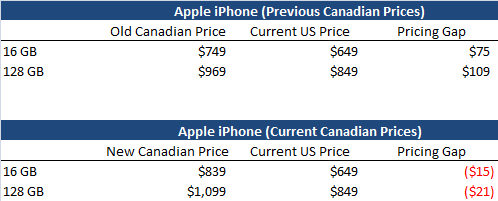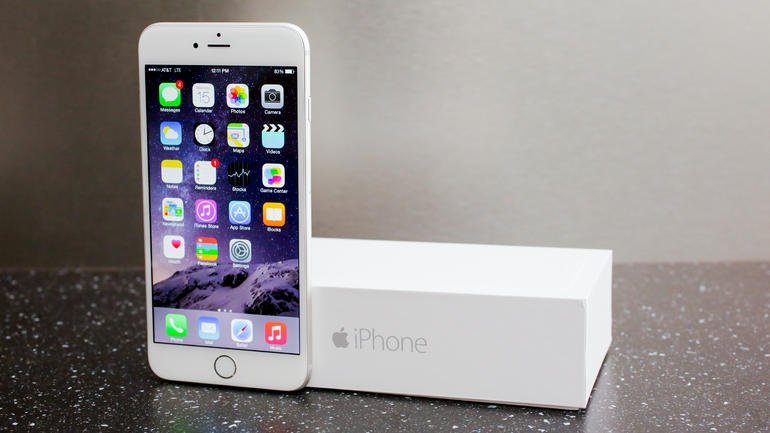The Math Behind Apple’s iPhone Price Increase in Canada
Over recent months the Canadian dollar has taken a nose dive, and we are starting to see the impact translate in to higher prices for electronic devices. For starters, iPhone prices just went up by about 12%! The main reason behind this is the falling Canadian dollar. This price increase was entirely predictable, here’s why.
Here’s the math behind why Apple needed to increase its prices.
The current price of the iPhone 6 16GB model in the US retails for USD $649, whereas here in Canada the same model used to retail for CAD $749. If we convert the US retail price to Canadian dollars at a $0.79 exchange rate, you would expect to pay about CAD $824 for the same iPhone (ie, if you bought the US iPhone with Canadian dollars). But the iPhone price in Canada was much lower and was selling in Canada at a CAD $75 discount!
The discount was even larger with the higher priced 128GB model with a discount of approximately CAD $109. Apple’s pricing in Canada was based on a Canadian dollar exchange rate of $0.86, but the Canadian dollar is currently worth much less than that.
Apple’s recent price adjustment for Canadian iPhone prices actually goes a bit too far and assumes the Canadian dollar will get even weaker. At this point in time, Canadian iPhone prices are more expensive than US retail prices.

It was long overdue for Apple to raise its Canadian iPhone (16GB) price from $749 to $839.
Imagine you’re a retailer selling the iPhone in Canada. Since you’re probably buying the iPhone from Apple in the United States, you are also likely paying them in US dollars. With the Canadian dollar having dropped about 15% in value relative to the US dollar, the next time you replenish your iPhone inventory it will cost you about 15% more in Canadian dollars to pay for the very same iPhone at the exact same US dollar price as you were paying before, mainly because the Canadian dollar has fallen in value over the last year. Essentially, it’s now 15% more expensive in Canadian dollars for retailers to buy an iPhone from Apple. It only makes sense that Canadian retailers will pass this cost increase on to their customers. That time has come.
Apple still has some pricing gaps!
We continue to see a pricing gap with Apple’s iPad Air 2; a CAD $85 gap on the 16GB model (currently retails for USD $499 vs. CAD $549) and jumping to CAD $119 gap on the 128GB model (currently retails for USD $699 vs. CAD $769). Apple and Canadian retailers are not likely to let pricing gaps this large last very much longer, especially if the Canadian Dollar continues its decline. If you’re considering buying an Apple iPad Air 2 in Canada, you can expect prices to go up soon!

We’ve already seen hints of what’s to come; In January Apple increased the base price in Canada for apps in their AppStore by 20%, from CAD $0.99 to CAD $1.19, citing a declining Canadian currency as the reason for this increase. A few days ago, Apple raised the price of its iPhone in Canada from C$749 to C$839, a 12% increase. Clearly raising prices of the iPad and other products seems to be the logical next step.
Does the Apple Watch have a pricing gap – US vs. Canada?
Unfortunately not. The Apple Watch will be available in retail stores on April 24, 2015. The expected price in Canada for the Apple Watch Sport is C$449 (38 mm version) while the US version retails for US$349. The Canadian price is in line with the recent exchange rate making virtually no difference in pricing when factoring in the exchange rate. The Apple Watch Gold Edition is going to retail for C$13,000 and the US retail price is US$10,000; converting the US retail price in to Canadian dollars at today’s exchange rate results in a price of C$12,700, indicating that the Canadian price is overpriced by $300. However, if the Canadian dollar keeps falling in value as most of the Canadian banks are forecasting, the Apple Watch Edition in Canada might end up being a deal!

Basically, if you’re looking to exchange money in Canada to buy an iPad, there’s still a deal to buying it in Canada vs. the US. Take advantage before the inventory that retailers purchased prior to the loonie dropping runs out and newly stocked inventory and newer models are all listed at higher prices to compensate for the lower Canadian Dollar exchange rate.
Photocredit: CNET.com












